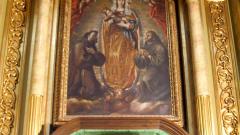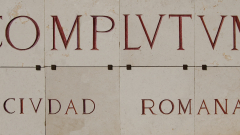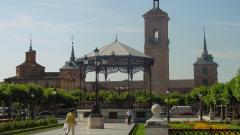alcala
Alcalá de Henares is a Spanish city belonging to the Community of Madrid. It has a population of 195.907 inhabitants, gathered in a territory of 87.72 km², and is 31 km away from the capital.
This town, known as the city of knowledge, is one of the three members of Madrid’s Royal Sites network, also, was the birthplace of the illustrious writer Miguel de Cervantes, author of "Don Quixote", and one of the most important universities nationwide. During the Middle Ages, it experienced its greatest period of splendor after the founding of the Universitas Complutensis, now the Complutense University of Madrid, under the guidance of Cardinal Cisneros (15th century). From that moment, and until the eighteenth century, the city became a meeting point for a multitude of scholars and students, this also makes possible the creation of numerous religious buildings (Monastery of Santa Úrsula and the Discalced Carmelites, the convent of Santa Clara, the hermitage of Cristo de los Doctrinos, etc.) due to the strong influence of the Catholic church in the educational system.
Some of the most relevant figures of Spanish culture, such as Francisco de Quevedo, Lope de Vega, Calderón de la Barca, Antonio de Nebrija, San Juan de la Cruz, San Ignacio de Loyola, were part of the institution, this fact, has established itself as one of the oldest and most prestigious internationally.
Even before the integral reform of Cardinal Cisneros and the appearance of Cervantes, due to the presence of several important streams that flow into the Henares, prehistoric tribes settled there, searching an ideal environment for the practice of agriculture and livestock. Archaeological remains also have been found in La Dehesa, El Cerro del Ecce Homo or El Juncal.
During Roman times, it takes the name of "Complutum" and consolidates as a city, serving as a strategic point for one of its roads, thanks to the intense trade it was a period of prosperity and wealth.
During the Muslim era, the city is walled in and converted into a military fortress known as Qal'at Abd al-Sälam, in order to contain Christian attacks and provide protection to the persecuted people.
The trace of different cultures, leaving in the city an enviable heritage, which, together with the past cultural revolution, has earned it recognition by UNESCO, in 1998, declared its Historic Site a World Heritage Site. In addition, it was the Capital of European Culture in 2016.
There are numbers of resources to enjoy, apart from the university and the Chapel of San Ildefonso we will highlight, the Plaza de Cervantes, the Corral de Comedias, the Magisterial Cathedral of los Santos Niños, the Puerta de Madrid, the Archbishop's Palace, Laredo Palace , The Oidor Chapel or Antezana Hospital.
As main museums we will mention The Regional Archaeological Museum, The House of the Griffins, The Hyppolytus House Museum, The Cervantes Birthplace, The Old Hospital of Santa María la Rica or The Iberoamerican Art Museum of the UAH.
The city, in turn, has great archaeological value, there are currently several protected areas for research due to its great relevance in the matter, we must emphasize the importance of the remains of the Ancient "Complutum" and those of the Muslim Fortress, together with the archaeological deposit of the Esgaravita.
In recent years, with the aim of boosting their activity have created several routes, guided tours and tourism products that to showcase the municipality aforementioned resources (The Train of Cervantes or The City of Three Cultures) among others.
It also has an agenda full of events and parties, its Easter celebration was declared a Festivity of Regional Tourist Interest, as well as the Cervantine Week or Don Juan Tenorio theatre performances, which usually take place on October 31 and November 1 of each year. Other notable events are The Carnival and its Classic Theater Festival.
After this overview we can see how Alcalá has managed to take advantage of its historical circumstances and also the emblematic figure of Miguel de Cervantes and "The Quixote" to build an attractive and solid tourism that can attract and welcome all kinds of public, drawing on, its proximity to the capital.



